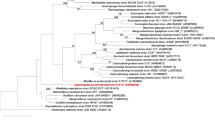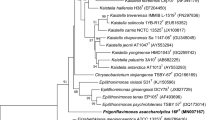Abstract
The component bacteria of a three-membered mixed culture able to ferment glycolate to acetate, propionate and CO2 were isolated in pure culture. All three strains were strict anaerobes that, on the basis of comparative 16S rRNA gene sequence analysis, belonged to the order Clostridiales in the phylum Firmicutes (low G+C gram-positive bacteria). Two of the strains were not involved in glycolate metabolism. The third, the glycolate-fermenting strain 19gly4 (DSM 11261), was related to members of the family Lachnospiraceae. The cells of strain 19gly4 were oval- to lemon-shaped, 0.85 µm long and 0.65 µm in diameter, occurring singly, in pairs, or in chains of up to 30 cells. Strain 19gly4 fermented glycolate or fumarate to acetate, succinate, and CO2. Hydrogen was not formed, and strain 19gly4 was able to grow on glycolate in pure culture without any syntrophic hydrogen transfer and without the use of an external electron acceptor. There was no evidence for homoacetogenic metabolism. This bacterium therefore differs in metabolism from previously reported glycolate-utilising anaerobes.



Similar content being viewed by others
References
Bateson MM, Ward DM (1988) Photoexcretion and fate of glycolate in a hot spring cyanobacterial mat. Appl Environ Microbiol 54:1738–1743
Beudeker RF, Kuenen JG, Codd GA (1981) Glycolate metabolism in the obligate chemolithotroph Thiobacillus neapolitanus grown in continuous culture. J Gen Microbiol 126:337–346
Buckel W, Janssen PH, Schuhmann A, Eikmanns U, Messner P, Sleytr U, Liesack W (1994) Clostridium viride sp. nov., a strictly anaerobic bacterium using 5-aminovalerate as growth substrate, previously assigned to Clostridium aminovalericum. Arch Microbiol 162:387–394
Chin KC, Liesack W, Janssen PH (2001) Opitutus terrae gen. nov., sp. nov., to accommodate novel strains of the division 'Verrucomicrobia' isolated from rice paddy soil. Int J Syst Evol Microbiol 51:1965–1968
Codd GA, Smith BM (1974) Glycolate formation and excretion by the purple photosynthetic bacterium Rhodospirillum rubrum. FEBS Lett 48:105–108
Codd GA, Bowien B, Schlegel HG (1976) Glycolate production and excretion by Alcaligenes eutrophus. Arch Microbiol 110:167–171
Coombs J, Whittingham CP (1966) The mechanisms of inhibition of photosynthesis by high partial pressures of oxygen in Chlorella. Proc R Soc Lond, Series B 164:511–520
Dorn M, Andreesen JR, Gottschalk G (1978) Fermentation of fumarate and l-malate by Clostridium formicoaceticum. J Bacteriol 133:26–32
Frenzel P, Bosse U (1996) Methyl fluoride, an inhibitor of methane oxidation and methane production. FEMS Microbiol Ecol 21:25–36
Friedrich M, Schink B (1993) Hydrogen formation from glycolate driven by reversed electron transport in membrane vesicles of a syntrophic glycolate-oxidizing bacterium. Eur J Biochem 217:233–240
Friedrich M, Schink B (1995) Isolation and characterization of a desulforubidin-containing sulfate-reducing bacterium growing with glycolate. Arch Microbiol 164:271–279
Friedrich M, Laderer U, Schink B (1991) Fermentative degradation of glycolic acid by defined syntrophic cocultures. Arch Microbiol 156:398–404
Friedrich M, Springer N, L udwig W, Schink B (1996) Phylogenetic positions of Desulfofustis glycolicus gen. nov., sp. nov., and Syntrophobotulus glycolicus gen. nov., sp. nov., two new strict anaerobes growing with glycolic acid. Int J Syst Bacteriol 46:1065–1069
Garrity GM, Winters M, Searles DB (2001) Taxonomic outline of the prokaryotic genera Bergey's manual of systematic bacteriology, 2nd edn. Release 1.0, http://www.cme.msu.edu/bergeys/
Godon JJ, Zumstein E, Dabert P, Habouzit F, Moletta R (1997) Molecular microbial diversity of an anaerobic digestor as determined by small-subunit rDNA sequence analysis. Appl Environ Microbiol 63:2802–2813
Gottschalk G (1986) Bacterial metabolism, 2nd edn. Springer, Berlin Heidelberg New York
Grech-Mora I, Fardeau ML, Patel BKC, Ollivier B, Rimbault A, Presnier G, Garcia JL, Garnier-Sillam E (1996) Isolation and characterization of Sporobacter termitidis gen. nov., sp. nov., from the digestive tract of the wood-feeding termite Nasutitermes lujae. Int J Syst Bacteriol 46:512–518
Huelsenbeck JP, Ronquist F (2001) MRBAYES: Bayesian inference of phylogenetic trees. Bioinformatics 17:754–755
Huelsenbeck JP, Ronquist F, Nielsen R, Bollback JP (2001) Bayesian inference of phylogeny and its impact on evolutionary biology. Science 294:2310–2314
Janssen PH (1990) Fermentation of glycolate by a mixed culture of anaerobic bacteria. System Appl Microbiol 13:327–332
Janssen PH (1991) Characterization of a succinate-fermenting bacterium isolated from a glycolate-degrading mixed culture. Arch Microbiol 155:288–293
Janssen PH (1998) Pathway of glucose catabolism by strain VeGlc2, an anaerobe belonging to the Verrucomicrobiales lineage of bacterial descent. Appl Environ Microbiol 64:4830–4833
Janssen PH, O'Farrell KA (1999) Succinispira mobilis gen. nov., sp. nov., a succinate-decarboxylating anaerobic bacterium. Int J Syst Bacteriol 49:1009–1013
Janssen PH, Liesack W, Kluge C, Seeliger S, Schink B, Harfoot CG (1996) Sodium-dependent succinate decarboxylation by a new anaerobic bacterium belonging to the genus Peptostreptococcus. Antonie van Leeuwenhoek 70:11–20
Janssen PH, Schuhmann A, Mörschel E, Rainey FA (1997) Novel anaerobic ultramicrobacteria belonging to the Verrucomicrobiales lineage of bacterial descent isolated by dilution culture from anoxic rice paddy soil. Appl Environ Microbiol 63:1382–1388
Lane DJ (1991) 16S/23S rRNA sequencing. In: Stackebrandt E, Goodfellow M (eds) Nucleic acid techniques in bacterial systematics. Wiley, Chichester, pp 115–175
Leser TD, Amenuvor JZ, Jensen TK, Lindecrona RH, Boye M, Moller, K (2002) Culture-independent analysis of gut bacteria: the pig gastrointestinal tract microbiota revisited. Appl Environ Microbiol 68:673–690
Lovley DR, Phillips EJP (1986) Organic matter mineralization with reduction of ferric iron in anaerobic sediments. Appl Environ Microbiol 51:683–689
Pfennig N (1978) Rhodocyclus purpureus gen. nov., sp. nov., a ring-shaped, vitamin B12-requiring member of the family Rhodospirillaceae. Int J Syst Bacteriol 28:283–288
Pfennig, N, Biebl H (1976) Desulfuromonas acetoxidans gen. nov. and sp. nov., a new anaerobic, sulfur-reducing, acetate-oxidizing bacterium. Arch Microbiol 110:3–12
Seifritz C, Fröstl JM, Drake HL, Daniel SL (1999) Glycolate as a metabolic substrate for the acetogen Moorella thermoacetica. FEMS Microbiol Lett 170:399–405
Stewart R, Codd GA (1981) Glycolate and glyoxylate excretion by Sphaerocystis schroeteri (Chlorophyceae). Br Phycol J 16:177–182
Stouthamer AH (1979) The search for correlations between theoretical and experimental growth yields. In: Quayle JR (ed) Microbial biochemistry. University Park , Baltimore, pp 1–47
Swofford DL (2002) PAUP*. Phylogenetic analysis using parsimony (*and other methods), version 4. Sinauer , Sunderland, Massachusetts
Tajima K, Aminov RI, Nagamine T, Ogata K, Nakamura M, Matsui H, Benno Y (1999) Rumen bacterial diversity as determined by sequence analysis of 16S rDNA libraries. FEMS Microbiol Ecol 29:159–169
Tajima K, Arai S, Ogata K, Nagamine T, Matsui H, Namakura M, Aminov RI, BennoY (2000) Rumen bacterial community transition during adaptation to high-grain diet. Anaerobe 6:273–284
Tanaka K, Mikami E, Suzuki T (1986) Methane fermentation of 2-methoxyethanol by mesophilic digesting sludge. J Ferment Technol 64:305–309
Thauer RK, Jungermann K, Decker K (1977) Energy conservation in chemotrophic anaerobic bacteria. Bacteriol Rev 41:100–180
Tolbert NE, Zill LP (1956) Excretion of glycolic acid by algae during photosynthesis. J Biol Chem 222:895–906
Widdel F, Bak F (1992) Gram-negative mesophilic sulfate-reducing bacteria. In: Balows A, Trüper HG, Dworkin M, Harder W, Schleifer KH (eds) The prokaryotes. A handbook on the biology of bacteria. Ecophysiology, isolation, identification, applications, 2nd edn. Springer, Berlin Heidelberg New York, pp 3352–3378
Acknowledgements
Prof. Dr. Bernhard Schink and Dr. Michael Friedrich are thanked for stimulating discussions regarding the anaerobic metabolism of glycolate. Paul Taylor's technical help is gratefully acknowledged.
Author information
Authors and Affiliations
Corresponding author
Rights and permissions
About this article
Cite this article
Janssen, P.H., Hugenholtz, P. Fermentation of glycolate by a pure culture of a strictly anaerobic gram-positive bacterium belonging to the family Lachnospiraceae . Arch Microbiol 179, 321–328 (2003). https://doi.org/10.1007/s00203-003-0528-5
Received:
Revised:
Accepted:
Published:
Issue Date:
DOI: https://doi.org/10.1007/s00203-003-0528-5




